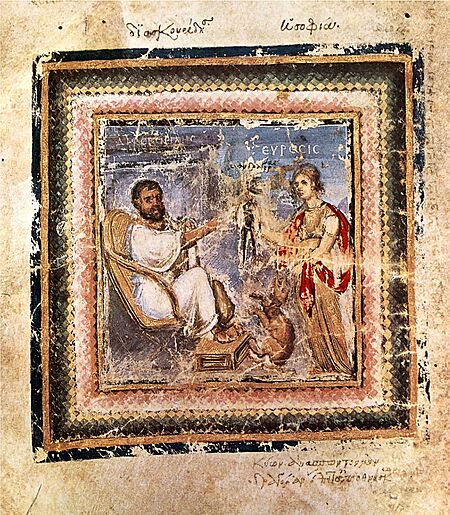History of plant systematics facts for kids
The history of plant systematics is about how people have tried to organize and name plants over time. Plant systematics is like creating a giant family tree for all plants. It helps us understand how different plants are related and what makes them special.
For a long time, people studied plants mainly to find medicines. Later, they became more interested in describing and classifying plants based on how they looked. Before the idea of evolution came along, most plant classification was based on a simple ladder-like system, where some plants were seen as "higher" than others. In the 18th and 19th centuries, scientists started to classify plants based on their real family connections.
Contents
Ancient Discoveries
In Ancient Greece, a smart thinker named Theophrastus (who lived from 372 to 287 BC) was a student of Aristotle. He wrote one of the first books about plants, called Historia Plantarum. In his book, he listed over 500 different kinds of plants. He didn't have a strict system for grouping them. Instead, he used common names and sorted them by their growth: trees, shrubs, or herbs.
Another important book from ancient times was De Materia Medica by Dioscorides. This book described more than 500 plants. It mainly grouped plants by what they could be used for, especially their medicinal effects.
Medieval Plant Studies
During the Middle Ages, Dioscorides' book was still very important. A copy of his book was even sent to the Caliph of Córdoba in the 9th century. A monk helped translate it into Arabic. This book was used for over 1500 years, showing how valuable it was for understanding plants and medicines.
In medieval times, the way plants were classified was different from today. Plants that looked similar on the outside were often given the same name. But today, we know that plants that look alike might actually be very different species.
An important plant book from the Andalusi region (parts of Spain and Portugal) was written by Abū l-Khayr. It is known for its detailed descriptions of how plants look and how they grow through the seasons.
Early Modern Classification Systems
In the 16th century, scientists like Otto Brunfels, Hieronymus Bock, and Leonhart Fuchs started to observe plants more closely. They helped bring back interest in studying nature directly. Bock even included details about where plants grew and their life cycles.
As explorers traveled the world, many new and exotic plants were discovered. The number of known plant species grew very quickly. However, most people were still more interested in the medicinal uses of plants than in creating a big classification system.
Later, important books came from Caspar Bauhin and Andrea Cesalpino. Bauhin described over 6000 plants. He organized them into 12 books and 72 sections, using many different features to group them. Cesalpino based his system on the structure of a plant's fruits and flowers.
In the late 1600s, two very important classification systems were developed. One was by the English botanist John Ray. He listed over 18,000 plant species. Ray was the first to divide plants into monocots and dicots (plants with one or two seed leaves). Some of his groups, like mustards, mints, legumes, and grasses, are still recognized today, though with different names. The other system was by the French botanist Joseph Pitton de Tournefort. His system was based on simple logical divisions and was popular in Europe before Linnaeus.
The book that really changed plant classification was Species Plantarum (1753) by Carl Linnaeus. It listed all the plant species known in Europe at that time. Linnaeus organized them based on the number and arrangement of their male and female parts (stamens and pistils). The highest group from his book that we still use today is the genus. Linnaeus also made it common to use binomial nomenclature, which means giving each plant a two-part scientific name (like Homo sapiens for humans). This made it much easier to identify and talk about plants.
Even though Linnaeus's system was very detailed, it was mainly a guide for identification. It didn't show how plants were related through evolution. Linnaeus believed that plant species were created as they were. He knew his system wasn't a "natural" one, meaning it didn't show true relationships.
Modern Plant Systematics
After Linnaeus, other scientists like de Jussieu and de Candolle made big contributions to plant classification.
A huge change in plant systematics came with Charles Darwin's theory of evolution, published in 1859. This led scientists to try and group plants based on their phylogenetic relationships, meaning their evolutionary family trees. New tools like the light microscope helped scientists study plant anatomy. Chemistry also helped by allowing them to analyze plant chemicals.
Today, scientists agree that a good classification system must show real evolutionary processes and genetic relationships. For a long time, they didn't have the technology to do this perfectly. But in the 1990s, DNA technology made huge progress. Scientists could collect lots of DNA information from different parts of plant cells.
In 1998, a major new classification system for flowering plants (called the APG system) was created. It used molecular phylogenetics, which looks at DNA similarities. This was a breakthrough because, for the first time, scientists could measure how related plants were by looking at their genetic code.
See also
- History of botany
- Conservation movement
- Environmental protection
- Ethnobotany
- Automated species identification
- Pl@ntNet


